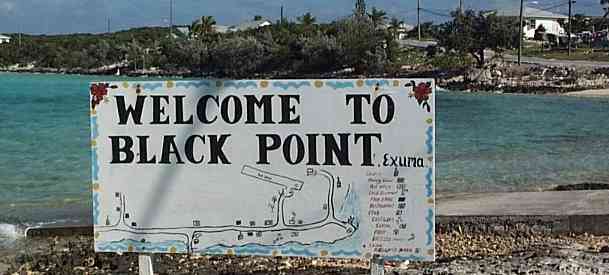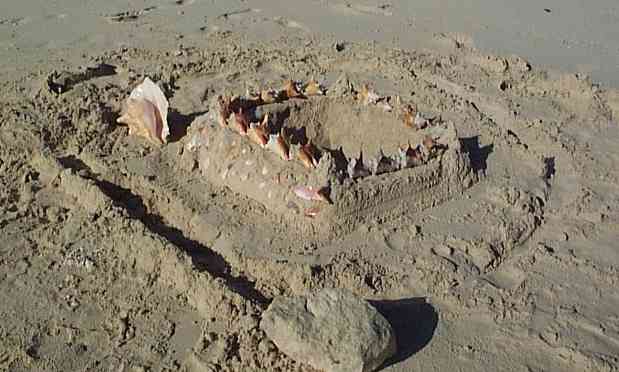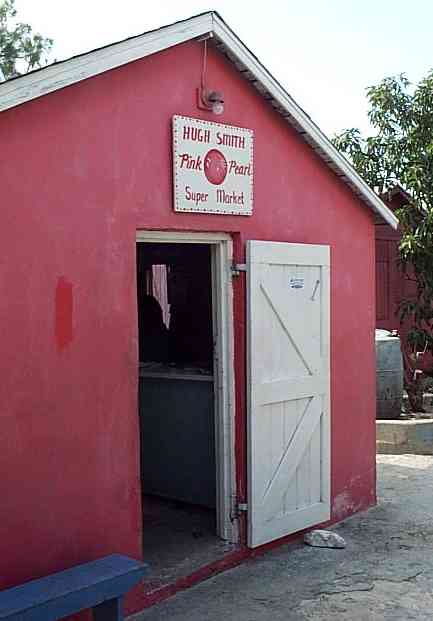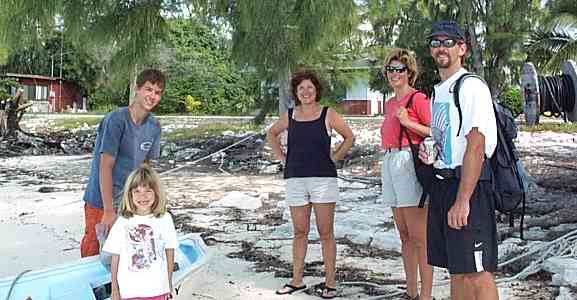Staniel Cay, 01/10/01
The weather fronts are now far enough apart that on 1/7
and again on 1/11 we will have seen the wind complete its travels around all the
points of the compass. This is a nice change of affairs from the constant
chilly winds always blowing NW to NE.
We departed with the rest of the flotilla about
9:30. The seas in the cut were running a good 5 feet, whipped into a
frenzy by the tidal current and wind. Different Drummer assessed the
situation quickly and stayed on the banks side. By the time they had made
their decision we were already in the thick of it so chose to go on
through. Once out on the Sound things settled down and we had a nice sail
down to the next cut where we re-entered the Banks. Even on the Banks the
winds were high enough and the water choppy enough that the dinghy
swamped. Nevertheless, we made over 7 knots and got to Big Majors Spot by
noon.
Staniel Cay is a popular stop for cruisers since it is
the first reliable opportunity to get food, water, and fuel. We used our
time here to get all three. The anchorage is about 2 miles from town, so
our trips there take forever. Almost definitely we have the wrong dinghy
and motor.
For entertainment here there are picnics on the beach
and visit to the pink and blue stores in town. Neither of these stores is
as big as a 7-11 at home, but offer good value since we haven't seen any
groceries for the last ten days.
There are also the tame pigs on Big Major Spot.
Black Point, Great Guana Cay, 1/13/01
Our trip down from Staniel was a nice downwind sail in
15 knots. With the wind from the NW the anchorage off Black Point
Settlement was not our cup of tea. Instead we went into Little Bay with
Frangipani, Different Drummer, Allura and Independence.
The beach at Little Bay has even finer sand than any we
have seen heretofore. It is so fine that it seems more like 10x
sugar. In some places you will sink into it over your ankles as though you
are walking in snow.
 |
Each settlement that we have visited
has had a map like this one in a central location. |
| Community art is also
commonplace. Both of these signs are indicative of the very friendly
people that one finds in the islands. |
 |
In the afternoon we hiked up to the settlement.
Black Point has a couple of little groceries and a couple restaurants. And
an airport. The passenger arrival building is really just a large gazebo.
On our way back to Little Bay we were accompanied by 8 little boys near in age
to Diana. They all went barefoot across the stretches of broken and sharp
stone and coral. They were also a font of knowledge about the local edible
flora. If you are going to eke out a living in this austere, dare I say
stark, environment then you had better start learning early.
Cave Key, 1/14/01
We've come here because one member of the flotilla
reports success last year fishing and conching. While the others went out
to the cut at Moosha Cay Diana and I stayed off the anchorage to snorkel for
conch in the grassy patches. It took us a while but we did find three
adult conch. We might have found more but an over curious barracuda chased
us out of the water.
 |
This is the dream castle that Diana
built on the beach at Cave Cay after we finished our successful conch
expedition. |
The wisdom is that one doesn't look directly at the
predator fish. Looking them in the eye is tantamount to challenging and
threatening them. If you look at them out of the corner of your eye they
will feel less threatened and see how large you are and move on. This
particular 'cuda came by for a look, came back for another look, then followed
me. I think he was attracted by Diana's uncoordinated splashing. So,
better safe than sorry.
In the afternoon the rest of the hunter - gatherers
showed up empty handed. Rather than be shown up by a 6 year old girl they
went off to where we had had our success. That evening we convened on
Independence for a conch feast. Most everyone decided that conch are too
much work to clean; they'll get theirs in a restaurant, thank you very
much.
Little Farmer's Cay, 1/15/01
This is a turn back to the north for us while the others
went on to the Caribbean Marine Research Center at Lee Stocking Island.
Little Farmer's is little indeed, but very quaint.
We gave a considerable boost to the economy; we bought two small
wood sculptures from J.R., had lunch at Ocean Cabin, and bought the Little
Farmer's burgee as a souvenir. Let's see, if the economic impact
multiplier is ....
 |
The sign on the door at Ocean Cabin
states its hours are:
"Most days about 9 or 10, occasionally as early as 7; but some days
as late as 12 or 1. We close about 5 or 6, or maybe 4 or 5.
Some days or afternoons we aren't here at all. And lately we've been here
about all the time, except when we're some place else. But we might
be here then, too." |
 |
J.R. putting Diana's name on the bottom
of her owl. |
With winds mostly from the east we anchored on the west
side of the island. There was a 30' wooden, gaff rigged sloop up on the
beach. We learned in town that this boat had brought 136 people from
Haiti. Unimaginable. The illegal business in the island now seems to
be trying to smuggle Haitians into the Bahamas and the U.S. When the
Haitians are caught in the Bahamas they are sent right back to Haiti. If
they land in the U.S. then there is some chance they may be able to remain if
the give the right answers to the INs.
Lee Stocking Island, 01/16/01
 Wind just right. Too much wind. Rain, a lot
in very short order. Wind from the wrong direction. No wind. Wind just
right. That about sums up our run down to Lee Stocking Island.
Christopher also caught a 2.5 foot wahoo that fed us for two nights.
Wind just right. Too much wind. Rain, a lot
in very short order. Wind from the wrong direction. No wind. Wind just
right. That about sums up our run down to Lee Stocking Island.
Christopher also caught a 2.5 foot wahoo that fed us for two nights.
While at Lee Stocking one can go ashore to walk around
the grounds of the Marine Research Center. During the winter there isn't
much going on. Summer, when all of the university faculty around the world
have no teaching responsibilities, is their high season. Nonetheless, it
is an interesting visit. Using Diana as an ice breaker we did get one of
the permanent staff to answer a few questions. We learned about the life
cycle of the conch. It takes about 3.5 years for a conch to reach maturity
for harvesting. You may know that the conch population in the Florida Cays
is seriously depleted. Recent research shows that it will take about 50
adult conch per hectare to rebuild a sustainable population in Florida.
From what I have seen, the Bahamians had better start giving some thought to
their conch population.
This anchorage is well worth a couple of days. It
is pretty and protected. Unfortunately we must move on since the Robert J.
Buck family has been waiting in Georgetown for us for almost a week.








 Wind just right. Too much wind. Rain, a lot
in very short order. Wind from the wrong direction. No wind. Wind just
right. That about sums up our run down to Lee Stocking Island.
Christopher also caught a 2.5 foot wahoo that fed us for two nights.
Wind just right. Too much wind. Rain, a lot
in very short order. Wind from the wrong direction. No wind. Wind just
right. That about sums up our run down to Lee Stocking Island.
Christopher also caught a 2.5 foot wahoo that fed us for two nights.